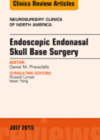
Journal Reviews
CSF leak – endoscopic or open repair?
Cerebrospinal fluid (CSF) rhinorrhoea is well known to the ENT surgeon. It commonly occurs secondary to a predisposing event such as accidental or iatrogenic trauma. When it occurs spontaneously, it can be associated with benign intracranial hypertension. The commonest CSF...






